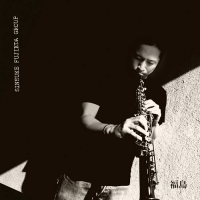Home » Jazz Articles » Reassessing » Pharoah Sanders: Pharoah Sanders: Thembi
Pharoah Sanders: Pharoah Sanders: Thembi
 Pharoah Sanders
Pharoah SandersThembi
Impulse!
1971
It is strange that two of the most striking albums made by saxophonist Pharoah Sanders during the first flush of late 1960s/early 1970s astral jazz have been so often overlooked in reissue series. Tauhid (Impulse!, 1967)—the recording which launched astral jazz, the style Sanders fashioned alongside harpist/pianist Alice Coltrane—and Thembi have been available only intermittently during the last 20 years.
Tauhid is unalloyed bliss from start to finish, a sweet and lyrical evocation of Eastern mysticism which established astral's template: prominent African and Asian percussion instruments; velvet-sandpaper saxophone vocalizations and multiphonics; hummable tunes and melody-centric improvisations; rock steady bass ostinatos; piano vamps; chanted vocals; rich collective grooves.
Thembi inhabits this territory over four of its six tracks, but steps out of it on the other two. The album was recorded during two sessions—in Los Angeles in November 1970 (tracks 1-3), and in New York City in January 1971 (tracks 4-6)—with some changes in personnel. Sanders, pianist Lonnie Liston Smith and bassist Cecil McBee were present at both sessions; violinist Michael White was in Los Angeles, though was featured little; traps drummer Roy Haynes and four percussionists replace Los Angeles' drummer Clifford Jarvis and percussionist James Jordan in New York.
The album opens with Smith's "Astral Traveling," a lush, sweeping group workout foursquare in the astral paradigm; in 1973, Smith, too, used it as an opening track, on his solo debut Astral Traveling, on ex-Impulse! producer Bob Thiele's Flying Dutchman label. The tune is given an exquisite performance on both albums, with Sanders' presence giving his Thembi version the edge.
But on Thembi, "Astral Traveling" proves to be the calm before the perfect storm. "Red, Black & Green," which follows, is as ferocious as is suggested by its title, a reference to the colors made emblematic by black liberation movements in the US and Africa. At 8:56 minutes, it is the second longest track on the album, and Sanders' overdubbed saxophones are foregrounded practically throughout, played in a style closer to the tumultuous one adopted by Sanders when he was a member of saxophonist John Coltrane's groups in 1966-67. Here, Sanders' sole concession is to play within a marginally more lyrical harmonic framework.
"Thembi" returns to the melodic, ostinato-driven palette of "Astral Traveling," before the album once more switches out of the astral comfort zone.
"Love," is an unaccompanied, 5:12 minute bass solo. If you are already reaching for the "skip track" button, don't do it. McBee turns in a corker, starting conventionally enough, albeit with frequent use of percussive, "Africanized" string-on-wood effects, before focusing on cleanly articulated high-harmonics (well recorded by producer Ed Michel and engineer Bill Szymczyk). Given all the tirelessly iterated ostinatos McBee contributed to Sanders' music—here and on Izipho Zam (Strata East, 1969) and Impulse!'s Jewels Of Thought (1970), Summun, Bukmun, Umyun (1970), Black Unity (1972), Wisdom Through Music (1972) and Village Of The Pharoahs (1973)—he was owed this five minutes alone, and he seizes them; "Love" is the sort of track that gives bass solos a good name.
The closing "Morning Prayer" and "Bailophone Dance" return to more familiar, collective astral territory. "Morning Prayer," at 9:11 minutes the longest track, revisits the fierce tenor heard on "Red, Black & Green," but in an amiable, ostinato-driven groove. "Bailophone Dance," built around a traditional West African cross-rhythm, makes good use of hand drummers Chief Bey, Majid Shabass, Anthony Wiles and Nat Bettis.
Delicious, essential listening.
Tracks: Astral Traveling; Red Black & Green; Thembi; Love; Morning Prayer; Bailophone Dance.
Personnel: Pharoah Sanders: tenor saxophone, soprano saxophone, bells, percussion, alto flute, bailophone, cow horn, fifes; Michael White: violin (1-3); Lonnie Liston Smith: piano, electric piano, percussion, shouts, bailophone (1-3, 5, 6); Cecil McBee: bass, bird effects; Clifford Jarvis: drums (1-3); Roy Haynes: drums (5, 6); James Jordan: ring cymbals (1-3); Chief Bey: African drums and percussion (5, 6); Majid Shabazz: African drums and percussion (5, 6); Anthony Wiles: African drums and percussion (5, 6); Nat Bettis: African drums and percussion (5, 6).
Photo Credit
Courtesy of Pharoah Sanders
Tags
Pharoah Sanders
Reassessing
Chris May
United States
Alice Coltrane
Lonnie Liston Smith
cecil mcbee
Michael White
Roy Haynes
Clifford Jarvis
John Coltrane
Ed Michel
PREVIOUS / NEXT
Support All About Jazz
 All About Jazz has been a pillar of jazz since 1995, championing it as an art form and, more importantly, supporting the musicians who make it. Our enduring commitment has made "AAJ" one of the most culturally important websites of its kind, read by hundreds of thousands of fans, musicians and industry figures every month.
All About Jazz has been a pillar of jazz since 1995, championing it as an art form and, more importantly, supporting the musicians who make it. Our enduring commitment has made "AAJ" one of the most culturally important websites of its kind, read by hundreds of thousands of fans, musicians and industry figures every month.


















